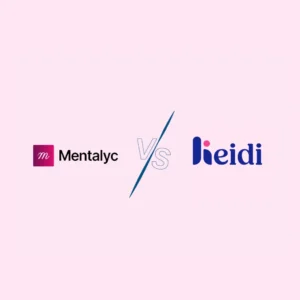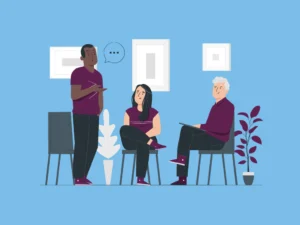Motivational Interviewing (MI) is a powerful counseling technique that motivates ambivalent clients to make a positive behavioral change. This method is widely applied in many settings, ranging from addiction treatment to mental health care. MI is used by therapists to help clients build insight that can be converted to actions.
In this article, we will look at MI’s purpose, core principles, and techniques. We will also highlight how therapists can effectively apply it in their practice.
The Purpose of Motivational Interviewing in Therapy and Mental Health Care
Motivational Interviewing is an evidence-based, goal-oriented technique that seeks to evoke the client’s reasons for making changes to their behavior. It is a clinical method that evolved from Carl Rogers’ client-centered approach. It emphasizes collaboration and autonomy. In MI, the therapist helps clients find their reasons for change within a supportive environment.
MI seeks to increase personal motive and dedication to set goals. This encourages the client’s intrinsic motivations and values rather than applying external pressures. MI is important in therapeutic settings, particularly for individuals having mixed feelings about change.
Originally, the technique was used only in the treatment of addiction but has now been used for other interventions. MI has been used in combination with CBT in treating disorders such as OCD, PTSD, anxiety disorders, and other health-risk behaviors. MI can be used to deal with ambivalence arising from medication non-adherence, gambling addiction, sexual risk behaviors, and stress management.
Core Principles of Motivational Interviewing
Motivational Interviewing begins with eliciting change talk. It encourages clients to express their reasons for wanting change. Before applying Motivational Interviewing, therapists need to understand the core principles guiding the technique. These core key principles that guide MI include the following: Expressing Empathy, Developing Discrepancy, Rolling with Resistance, and Supporting Self-Efficacy.
Expressing empathy involves actively listening to your client. As a therapist it is important to show that you understand the client, their emotions and experiences. This gives room for the client to share them openly.
Developing discrepancy helps your client see the gap between where they are and where they want to be. Your goal as a therapist is to guide the client to recognize how their current behavior conflicts with their desired behavior. Although this can create cognitive dissonance, it is a powerful motivator for change. The client begins to feel the urge to resolve the conflict by making changes. Then, the client can gain insight on why the change of their current behavior is needed.
When resistance arises, rolling with it prevents confrontational response. You can approach the client gently in a way that respects the client’s autonomy. Finally, supporting self-efficacy boosts the motivation and confidence of your client. It makes them see that they can make the meaningful change they desire.
How Motivational Interviewing Works in Practice
Miller and Rollnick (1995) focuses on the Interpersonal Spirit of MI which contributes to its efficacy in practice. This includes:
Collaboration Between Therapist and Client in MI
This is a partnership between the mental health practitioner and the client. While assisting the client in the change process, the therapist creates an environment where clients feel comfortable exploring their thoughts and feelings without judgement. Therapists do not impose their perspectives on the client rather, they focus on the client’s viewpoint. This way, the therapist only acts as a ‘facilitator’ guiding the client to deal with any ambivalence or reluctance to change.
Respecting Client Autonomy in Motivational Interviewing
MI is based on respecting the autonomy of clients. Therapists understand that their clients have the right to make life decisions based on their beliefs and values. As a result, MI encourages a sense of responsibility that strengthens the commitment to change. It gives clients the freedom to take charge of their own choices.
Evocation
Evocation involves finding the client’s innate reasons for wanting to change. Therapists encourage clients to explain their own motivations for wanting change rather than giving answers or instructions. This procedure makes the motivation for change more powerful and very personal. Evocation helps clients connect their values to their objectives.
Techniques Used In Motivational Interviewing
There are various techniques used in MI to bring about change in behaviors. These include Open-ended questions, Affirmations, Reflective Listening, and Summarizing. These are denoted by the acronym OARS.
Open-Ended Questions
Open-ended questions are essential MI tools that enable clients to express themselves freely. These questions allow deep investigation of ideas and emotions relating to behavior modification. The goal is to encourage the client to explore ambivalence and/or concerns.
Affirmations to Build Confidence in MI Counseling
Affirmations are inspiring statements that acknowledge the client’s accomplishments and efforts toward change. This technique strengthens the belief that clients can accomplish their goals and increase their confidence. The goal is to acknowledge the client’s self-worth and autonomy.
Reflective Listening for Deeper Client Insight in MI
Reflective listening entails restating or paraphrasing what the client has said. This technique shows understanding and empathy. It encourages clients to evaluate their motivations deeply and helps them make sense of their thoughts. Here, the goal is to reflect the client’s perspective. This helps build rapport and ensure understanding between the two parties.
Summarizing
Summarizing involves condensing discussion points into concise statements that cover the main ideas discussed. In addition to reinforcing understanding, this method lays the groundwork for upcoming discussions regarding change.
Application of MI Techniques: Example of A Conversation between Client and Therapist
Client: I know I have been lashing out, but I just can’t help it because of my traumatic experiences. It’s as if I keep reliving them!
Therapist (Reflective Listening): I hear you! If I understand correctly, you’re saying that you’re aware that your behavior is causing you distress. At the same time, you feel overwhelmed by the trauma you’ve experienced. It’s almost as if your emotions are taking over.
Client: (nods) Yes, that’s exactly how I feel.
Therapist (Open-Ended Questioning): Can you tell me more about what happens when you feel overwhelmed by your emotions? What goes through your mind and body in those moments?
Client: (pauses) I feel like I’m losing control. My heart begins to race and I feel this unexplainable intense anger.
Therapist (Affirming + Open-Ended Questioning): I can imagine how terrifying that must really be for you. It takes a lot of courage to accept and share your experiences with me. Can you recall a time you felt like you were in charge of your emotions or that you responded differently to a situation that triggered you?
Client: (ponders) Actually, yes. There was this one time I took a step back and took a deep breath. I think I reminded myself that I was safe and that the trauma wasn’t reoccurring at that present moment.
Therapist (Affirming): That’s a huge accomplishment! It really sounds like you’re developing some coping strategies that can help you regulate your emotions. I want to acknowledge your resilience and strength in the face of trauma. That’s great! Taking a deep breath and reminding yourself that you’re safe is a big step. It sounds like you’re finding ways to manage your emotions, which is really important.
Client: (slightly smiles) Thank you. Just talking about this makes me feel a bit better.
Therapist (Summarizing + Open-Ended Questioning): We’ve talked about how overwhelming the emotions can be and how you’ve managed them. What do you feel would be most helpful for you to work on next?
Client: I think I’d like to work on developing more coping skills to manage my emotions.
Therapist: That sounds like a wonderful goal. I’m looking forward to continuing the session together.
The Change Process in Motivational Interviewing
In Motivational Interviewing, the change process measures the changes that occur in the client’s behavior throughout therapy. It is used to track changes and measure outcomes of treatment.
The change process is also known as the transtheoretical model (TTM) of behavior change. It was developed by Prochaska and DiClemente in 1983. The theory states that individuals progress through six stages of change.
It is important to state that these stages do not always sequentially follow through. That is, individuals can progress or regress between these stages of change. The stages of change include:
Precontemplation Stage in Motivational Interviewing Therapy
In this phase, the client is either ignorant of change or unwilling to consider it.
For example:
Client: “I don’t think I have an addiction!”
1. Open-Ended Questions: “Can you help me understand what makes you think you don’t have an addiction?”
2. Reflective Listening: “Just to make sure I understand. You’re saying that you feel you’re in control of your drinking. And you think so because you only drink on weekends and believe you can stop anytime?”
3. Affirmations: “I appreciate your honesty, and I’m glad you feel confident in your ability to control your drinking. That takes a lot of self-awareness.”
4. Summarizing: “So, from what I hear you saying, you don’t think you have an addiction because you believe you’re in control of your drinking. Did I get that right?”
Contemplation Stage: Building Readiness for Change in MI
Although the client is aware that change is necessary, they may be torn about taking action(s).
For Example:
Client: “I’m not sure…I’ve been drinking frequently lately, and I’m beginning to feel like I might have a drinking problem!”
1. Open-ended questions: “What has made you start thinking you have a problem with drinking?”
2. Reflective Listening: “It sounds like you’re starting to recognize some patterns and their impact. Can you tell me more about what you hope to achieve after addressing your drinking habit?”
3. Affirmations: “I appreciate your willingness to explore this issue and consider making some changes. That really takes a lot of courage.”
4. Summarizing: “If I understand correctly, you’re starting to consider that there might be a problem with drinking. You’re also thinking of making some changes. Is that right?”
Preparation Stage: Goal-Setting with Motivational Interviewing
In the preparation stage, the client starts making plans for change. They also establish goals, objectives, and think about actions they can take.
For Example:
Client: “I’ve decided that I want to cut back on my drinking habit. I am not sure how to do it, but I think I am willing to give it a try”
1. Open-ended questions: “What do you think is the most challenging part of cutting back on your drinking and how do you plan to overcome this challenge?”
2. Reflective Listening: “Sounds like you’re already thinking about managing high-risk situations and finding alternative activities. That’s a great start!”
3. Affirmations: “I’m impressed by your commitment and willingness to make a change.”
4. Summarizing: “So, you’ve decided to cut back on your drinking and think about how to manage this challenging situation and find alternative activities. Is that correct?”
Action Stage: Applying MI Techniques for Lasting Change
The action phase involves actively putting change-related strategies into practice.
For Example:
Client: “I’ve been working on cutting back on my drinking, but it’s not been easy!”
1. Open-Ended Questions: “What has been helpful for you so far and what do you think you need to improve on?”
2. Reflective Listening: “It sounds like you’re starting to recognize the importance of social support and stress management.”
3. Affirmations: “You’ve been putting in a lot of effort, and that’s something to be really proud of.”
4. Summarizing: “So, you’ve been actively working on cutting down on drinking and making adjustments. Is that right?”
Maintenance Stage: Preventing Relapse with Motivational Interviewing
In this phase, clients actively avoid relapse, and strive to maintain their progress over time.
For Example:
Client: “I’ve been maintaining my reduced drinking habits for quite a while now”
1. Open-Ended Questions: “What do you think has helped you maintain this progress?”
2. Reflective Listening: “It sounds like you’re recognizing the importance of continued support and self-care in cutting back on drinking.”
3. Affirmations: “I’m impressed by your commitment to maintaining your goals.”
4. Summarizing: “You’ve been consistent in your efforts, relying on support systems and healthy habits to maintain your progress. Does that sound right?”
Termination Stage: Achieving Long-Term Success with MI
Termination represents the success in achieving or maintaining the desired change in behavior.
Conclusion
Change can be daunting. It is natural for clients to show resistance to change, even when the change is aimed at improving their wellbeing. The goal of therapists using Motivational Interviewing is to help clients become less hesitant to change and resolve their ambivalence.
Motivational Interviewing is a flexible way to manage a range of behaviors in mental health care. The therapeutic technique combines the stages of change and the OARS technique to bring about behavior change. The OARS technique supports clients as they progress through the stages of change.
Therapists can use Mentalyc, an AI note-taking tool, to easily document client progress. It helps track changes and adjust treatment plans for more effective care. When used effectively, Motivational Interviewing helps clients overcome resistance and make lasting changes. It is important to state that this technique should only be applied by a trained mental health professional within a safe environment.
FAQs on Motivational Interviewing in Mental Health
What Are The Misconceptions Regarding Motivational Interviewing?
Given the name, some think MI is an easy, quick fix that is used to manipulate, directly persuade or convince people to change their behavior. However, MI is a structured, client-centered approach. It mainly relies on specific collaborative techniques. Its core principles seek to explore the client’s resistance to change and the client’s motivation for change. Some people assume that MI is only used for addiction treatment. Although it was originally designed for addiction treatment, it is now being used for a wide range of behavioral change goals. This includes health, wellness and personal development.
MI is conducted by a trained therapist who understands that MI is not directly based on Prochaska’s Transtheoretical Model of Change (TTM). Although, therapists may use TTM alongside MI. While TTM helps categorize a client’s stage of change, therapists do not need to place clients in a specific stage before using MI. Motivational Interviewing is more about guiding clients through their thoughts and motivations, regardless of the stage they are in.
Are There Situations Where Motivational Interviewing Might Not Be Effective?
Yes! MI might not work for clients who prefer a directive technique. Also, clients who are already highly motivated, or extremely unmotivated might not benefit from MI. Clients who completely deny their problem, have acute crises or severe mental health conditions i.e. psychosis may find MI less effective. Therapists without proper training and practice might not be able to effectively use MI techniques.
Are Motivational Interviewing Techniques A Compulsory Skill for Mental Health Therapists?
Motivational Interviewing is an evidenced-based approach (EBP). However, its techniques are not a compulsory skill for mental health practitioners. It is only useful and effective for therapists who are focused on promoting a collaborative therapeutic relationship. This is because MI is aimed at helping clients explore their own motivations and goals for change.
Which Motivational Interviewing Trainings For Mental Health Professionals Are Available?
As a mental health therapist, you can learn MI from reputable, dedicated training course programs, and workshops.
Why other mental health professionals love Mentalyc

“For those who have hesitations … It is a lifesaver. It will change your life and you have more time to be present with your patients.”
Licensed Clinical Social Worker

“If I were recommending this software to a colleague, I would tell them that it is the best thing that they could do for their practice.”
Licensed Professional Counselor

“Do yourself a favor, make your life easier. Use the tools that are readily available … I found Mentalyc to be one of the best tools that I’ve ever used.”
Licensed Marriage and Family Therapist

“It immediately changed my quality of life, personally and professionally. I went from 3–4 hours a week of notes to 1 hour at most … that alone is invaluable personally and professionally.”
Owner/Independently Licensed Marriage & Family Therapist (IMFT)






